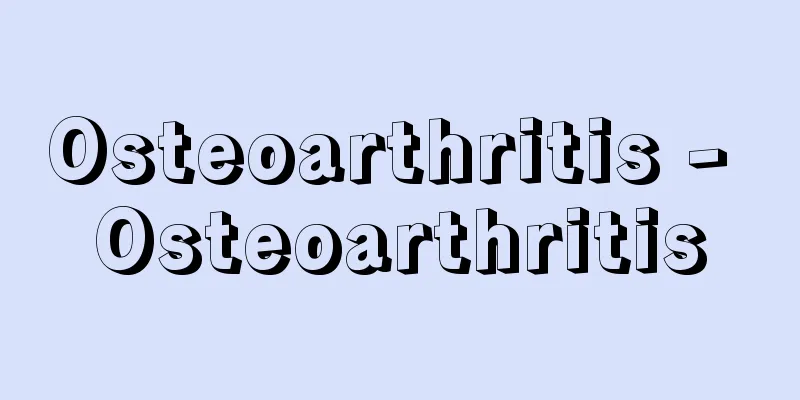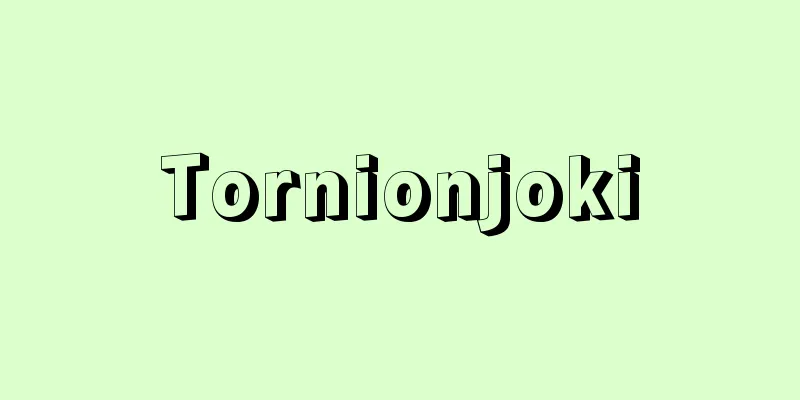Osteoarthritis - Osteoarthritis

|
Osteoarthritis, which causes deformation of the inside of joints , is a disease caused by aging of joints. As we age, the cartilage in our joints, especially the cartilage that bears our weight, wears down, and at the same time, the bones in the joints that do not bear our weight become deformed. There is no way to restore worn cartilage to the smoothness of younger people's cartilage. Therefore, people who are prone to this disease, such as those with severe bow legs, those who were treated for congenital hip dislocation when young, those who use vibrating tools or do heavy work, and those who have fractures involving the joints that leave the joint surface slightly uneven, should be careful as they may develop symptoms as they age. When symptoms occur in the knee joint, it is called osteoarthritis of the knee ("osteoarthritis of the knee"); when symptoms occur in the hip joint, it is called osteoarthritis of the hip ("osteoarthritis of the hip"); and when symptoms occur in the elbow joint, it is called osteoarthritis of the elbow ("osteoarthritis of the elbow"). ◎ Precautions in daily life Precautions in daily life include: ①Do not put undue strain on your joints. ②Don't let your joints get cold. ③Don't fall. There are three main reasons: Regarding ①, moderate walking is fine, but forcing yourself to go jogging or mountain climbing even if you have some pain is not good. It is better to think of pain as a warning sign from your joints. There are some exercises that don't involve putting weight on the body but help stabilize the joints. For the knees, you can train the muscles around the hip joint by lying on your back with your legs stretched out and raising and lowering them, or by turning to your side and raising and lowering your legs. Regarding ③, even people who have never had symptoms before may have already experienced changes in the cartilage of their joints, and may experience sudden pain or blood accumulation in the joints when they fall, causing symptoms. I think it is a good idea for elderly people to use a cane to prevent falls, especially since it reduces the strain on the joints. ◎This is a disease in which drug therapy and surgery progress gradually with the patient's age, so even if the pain temporarily disappears with anti-inflammatory analgesics or injections, it is best to continue to be careful in your daily life. Even if you have no symptoms, it is important to see a doctor regularly and have X-rays taken. If the pain persists, surgery can be done to relieve it. Details will be explained in the sections for each type of osteoarthritis, but the surgical method varies depending on the symptoms and the degree of joint deformity. Before deciding to have surgery, you should consult with an orthopedic surgeon to find out what symptoms will improve and what symptoms may remain. Also, even if you are elderly, if you have symptoms, do not give up and consult an experienced doctor. Source: Shogakukan Home Medical Library Information |
|
◎関節の内側が変形する 変形性関節症は、関節の老化によっておこる病気です。年齢とともに、関節にある軟骨、とくに体重がかかる軟骨はすり減っていき、それと同時に、体重がかからない部分では、関節の骨が変形していきます。 すり減った軟骨を、若い人のようなつるつるした軟骨にもどす方法はありません。したがって、この病気にかかりやすい人、たとえば膝(ひざ)ではO脚(オーきゃく)の程度がひどい人、股関節(こかんせつ)では小さいときに先天性股関節脱臼(せんてんせいこかんせつだっきゅう)の治療を受けた人、肘(ひじ)では振動工具や力仕事をする人、関節にかかわる骨折をおこして関節面にやや段差が残った人などは、年齢とともに症状が出てくる可能性があるので、注意が必要です。 膝の関節に症状がおこった場合を変形性膝関節症(へんけいせいしつかんせつしょう)(「変形性膝関節症」)、股関節に症状がおこった場合を変形性股関節症(へんけいせいこかんせつしょう)(「変形性股関節症」)、肘の関節に症状がおこった場合を変形性肘関節症(へんけいせいちゅうかんせつしょう)(「変形性肘関節症」)といいます。 ◎日常生活の注意点 日常生活での注意としては、 ①関節にむりな負担をかけない。 ②関節を冷やさない。 ③転ばない。 の3つがあげられます。 ①については、適度な散歩はよいのですが、多少の痛みがあるのに、むりしてジョギングや山登りなどをするのはよくありません。痛みは関節の警報と考えたほうがよいと思います。 同じ運動でも、体重をかけないで、関節の安定に役立つ運動があります。 膝では、あおむけで脚(あし)を伸ばして上げ下げ運動をしたり、横をむいて脚を上げ下げすれば、股関節周囲の筋肉を鍛えることができます。 ③については、今まで症状のなかった人でも、関節の軟骨はすでに変化がおこっていることもあり、転倒すると急に痛みが出たり関節に血がたまったりして、症状が出ることがあります。 とくにお年寄りでは、転ばないように、つえをつくのはよいことだと考えます。関節への負担を少なくする点でもよいでしょう。 ◎薬物療法と手術が治療の基本 年齢とともに少しずつ進行していく病気ですので、一時的に消炎鎮痛薬(しょうえんちんつうやく)や注射で痛みが消失しても、日常生活の注意は続けたほうがよいでしょう。 症状がなくても、定期的に医師にかかり、X線写真を撮ってもらうこともたいせつです。 痛みが続く場合は、手術で痛みを軽減させることができます。 詳しくはそれぞれの変形性関節症の項で解説しますが、症状や関節の変形の程度によって手術方法が異なります。 手術は、これによってどんな症状がよくなり、どんな症状が残る可能性があるかなど、整形外科医に十分に相談して決定すべきです。 また、たとえ高齢であっても、症状がある場合は、あきらめずに経験のある医師に相談してください。 出典 小学館家庭医学館について 情報 |
<<: Crassulaceae - Crassulaceae
Recommend
Outline of the Japan Reform Bill - Nihon Kaizo Hoantaiko
This is a programmatic work written by Kita Ikki ...
Kanna River
A river that flows through the southwestern part ...
Kyoto Funeral Hall
...The place where rice brought from the two Saik...
Nuraghe
...For example, in Puglia and Sardinia, there rem...
Uzun Hawa - Uzun Hawa
A rhythmic style of Turkish folk songs. It is sung...
Cosmic rays
High-energy radiation of extraterrestrial origin....
Cold wave - Kanpa
A phenomenon that mainly occurs in winter, in whi...
CCD - Colony Collapse Disorder
A phenomenon of unknown cause in which a large num...
Ken Domon
Photographer. Born in Yamagata Prefecture. Active...
Louis le Pieux (English spelling) Louis le Pieux
…reigned 814-840. Also known as Ludwig the Pious ...
Scarlet runner bean (Benihana Ingen) - Scarlet runner bean (English spelling)
Also known as the flower bean (illustration). A pe...
Schlegel, Friedrich von
Born: March 10, 1772, Hanover [Died] January 12, 1...
Veterinarian - Juui
The correct term is veterinarian. A veterinarian i...
Chandogya-upaniṣad (English spelling)
…Years of birth and death unknown. His ideas are ...
IBF System - IBF System
...This is a system called the International Bank...









